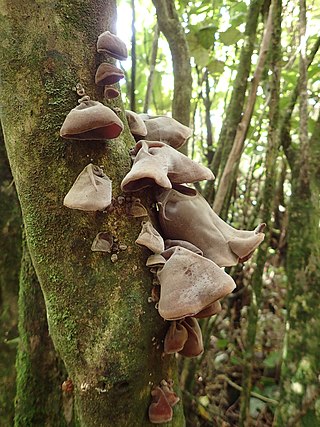
Auricularia cornea, also known as cloud ear, is a species of fungus in the order Auriculariales. It is commercially cultivated for food in China. Auricularia cornea is a popular ingredient in many Chinese dishes and is also used in traditional Chinese medicine.

The Auriculariales are an order of fungi in the class Agaricomycetes. Species within the order were formerly referred to the "heterobasidiomycetes" or "jelly fungi", since many have gelatinous basidiocarps that produce spores on septate basidia. Around 200 species are known worldwide, placed in six or more families, though the status of these families is currently uncertain. All species in the Auriculariales are believed to be saprotrophic, most growing on dead wood. Fruit bodies of several Auricularia species are cultivated for food on a commercial scale, especially in China.

The Auriculariaceae are a family of fungi in the order Auriculariales. Species within the family were formerly referred to the "heterobasidiomycetes" or "jelly fungi", since many have gelatinous basidiocarps that produce spores on septate basidia. Around 100 species are known worldwide. All are believed to be saprotrophic, most growing on dead wood. Fruit bodies of several Auricularia species are cultivated for food on a commercial scale, especially in China.

The Hyaloriaceae are a family of fungi in the order Auriculariales. Species within the family have gelatinous basidiocarps that produce spores on septate basidia and, as such, were formerly referred to the "heterobasidiomycetes" or "jelly fungi". All appear to be saprotrophic, growing on dead wood or plant remains. Less than 30 species are currently included within the Hyaloriaceae, but the family has not been extensively researched.
Eichleriella is a genus of fungi in the order Auriculariales. Species produce effused or cupulate, waxy to leathery basidiocarps on wood, with a smooth to spiny surface. The genus currently contains more than 15 species.
Heterochaete is a genus of fungi in the order Auriculariales. Species produce effused, gelatinous, waxy, or leathery basidiocarps on wood, partly or wholly covered in small sterile spines or pegs. The presence of these sterile spines distinguishes the genus from Exidiopsis, species of which are microscopically similar but have smooth basidiocarps.

The Ceratobasidiaceae are a family of fungi in the order Cantharellales. All species within the family have basidiocarps that are thin and effused. They have sometimes been included within the corticioid fungi or alternatively within the "heterobasidiomycetes". Species are saprotrophic, but some are also facultative plant pathogens or are associated with orchid mycorrhiza. Genera of economic importance include Ceratobasidium and Rhizoctonia, both of which contain plant pathogenic species causing diseases of commercial crops and turf grass.
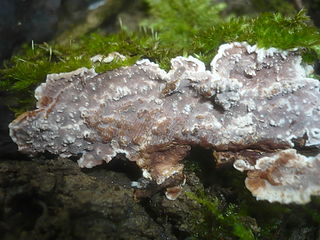
Heteroradulum is a genus of fungi in the order Auriculariales. Species produce effused, leathery basidiocarps on wood, often pinkish red and partly or wholly covered in small sterile spines. The genus was originally published in 1917 by American mycologist Curtis Gates Lloyd under the facetious pseudonym "McGinty", rendering the name invalid. It was validated a century later to accommodate a group of species formerly placed in the genera Eichleriella or Heterochaete, but not closely related to either.
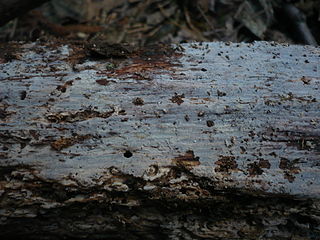
Basidiodendron is a genus of fungi in the order Auriculariales. Basidiocarps are corticioid, thin, effused and are typically found on fallen wood. The genus is widespread in both temperate and tropical regions and contains over 30 species.
Hauerslevia is a fungal genus of uncertain familial placement in the order Auriculariales. The genus is monotypic, containing the single species Hauerslevia pulverulenta, known from Europe.

Auricularia nigricans is a species of fungus in the family Auriculariaceae. Basidiocarps (fruitbodies} are gelatinous, ear-like, and grow on dead wood of broadleaf trees. It is found in southern and eastern Asia, North America, South America and the Caribbean. Asian examples were formerly considered as a separate species described as Auricularia polytricha.
Elmerina is a genus of fungi in the order Auriculariales. Basidiocarps are formed on dead wood and are either bracket-like with a poroid hymenium or densely clavarioid. Species are known from East Asia and Australia.
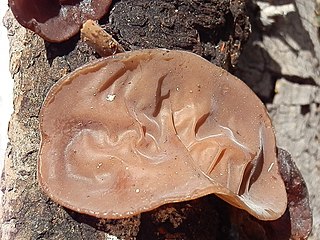
Auricularia americana is a species of fungus in the family Auriculariaceae. Basidiocarps (fruitbodies} are gelatinous, ear-like, and grow on dead conifer wood. The species was formerly confused with Auricularia auricula-judae, which grows on broadleaf wood and is confined to Europe.

Auricularia angiospermarum is a species of fungus in the family Auriculariaceae. Basidiocarps (fruitbodies) are gelatinous, ear-like, and grow on dead wood of broadleaf trees. It is a North American species and was formerly confused with Auricularia auricula-judae which is confined to Europe.
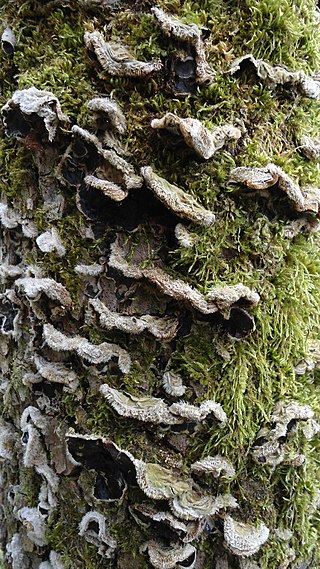
Auricularia mesenterica, commonly known as the tripe fungus, is a species of fungus in the family Auriculariaceae. Basidiocarps are gelatinous and typically formed in coalescing tiers on stumps and logs. They are partly pileate, with hirsute, zoned caps, and partly resupinate, with smooth to wrinkled undersurfaces that spread over the wood. Auricularia mesenterica is a saprotroph on dead deciduous trees and shrubs. The species is restricted to Europe and Central Asia.
Adustochaete is a genus of fungi in the family Auriculariaceae. Species produce effused basidiocarps on wood, typically covered in small sterile spines or pegs. The genus was created as a result of molecular research, based on cladistic analysis of DNA sequences, to accommodate two species from Brazil and Mexico that are not closely related to the older and superficially similar genus Heterochaete. Two additional species, from Brazil and China, have since been described.

Tremellochaete is a genus of fungi in the family Auriculariaceae. Species produce pustular or lobed, effused, gelatinous basidiocarps on wood, typically covered in small sterile spines or pegs.
Proterochaete is a genus of fungi in the family Auriculariaceae. The type and only species, Proterochaete adusta, produces thin, effused, corticioid basidiocarps with a smooth or spiny surface on wood. The species was originally described from North America and is also known from northern Europe and Asia.
Mycostilla is a genus of fungi in the order Auriculariales. The type and only species, Mycostilla vermiformis, forms effused, gelatinous, crystalline or net-like basidiocarps on fallen conifer wood in Europe. The species was formerly placed in Stypella, but the latter genus is of uncertain disposition and appears unrelated to the Auriculariales. Molecular research, based on cladistic analysis of DNA sequences, distinguishes Mycostilla from the morphologically similar genus Stypellopsis.
Psilochaete is a genus of fungi in the order Auriculariales. The type and only species, Psilochaete multifora, forms effused, gelatinous, basidiocarps that are reticulate (net-like). Molecular research, based on cladistic analysis of DNA sequences, indicates that Psilochaete is distinct from Protomerulius and similar genera. The species was originally described from Norway.











